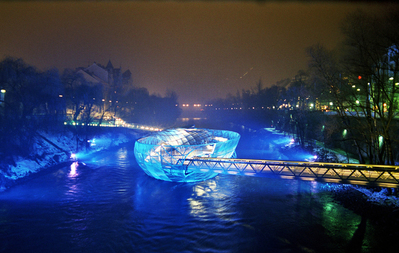VITO ACCONCI: THINKING SPACE
At the heart of this aptly titled exhibition is Vito Acconci’s first permanent commission, Way Station I (Study Chamber), a piece that ignited a controversy and inspired a collection.
In 1983 the provocative performance and video artist was invited to Middlebury College to participate in an on campus residency program. During this period, he worked collaboratively with students to construct a closet-like structure of steel, concrete, spray enamel and mirror that incorporated painting and design, architecture and politics. An interior underground space was included that might serve as a study room and was accessible to passers-by. It was sited in a highly visible place on the college grounds.
Soon after its installation came a public outcry and demand to have the piece removed. One part of the current exhibition is dedicated to the documentation of the controversy involving students, faculty, and administration as well as the surrounding community. Spanning several years, the discontent culminated in a fire that resulted in the destruction and removal of the work in 1985. A large, grainy, black-and-white photo reproduction shows the charred remains of the piece in storage following this act of vandalism.

Vito Acconci, Mur Island, 2003, installation, Graz, Austria.
Thirty years later, thanks in part to the persistence of museum director Richard Saunders and chief curator Emmie Donadio, in consultation with the artist, Way Station I has been restored. Materials were salvaged from the original. The work is reinstalled near the pond behind the Mahaney Center for the Arts. No longer a battleground for public art, in 1994 the institution adopted a “One Percent for Art” policy that has resulted in one of the most important on campus sculpture collections of any American liberal arts college. It includes a wide range of aesthetic approaches from Tony Smith to Joseph Beuys and now, Acconci’s Way Station I.
Acconci’s Middlebury experience provided a critical turning point in his career, leading to the founding of Acconci Studio in Brooklyn, whose design work has expanded to include clothing and automobiles as well as public spaces. A selection of the Studio’s best known projects are documented in the Vermont exhibition and catalogue, including Mur Island, Graz, Austria 2003, Wave-A-Wall, Coney Island, 2006, and 13 other public and private works.
